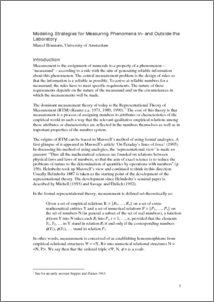Boumans, Marcel
(2009)
Modeling Strategies for Measuring Phenomena In- and Outside the Laboratory.
In: UNSPECIFIED.
![[img]](https://philsci-archive.pitt.edu/style/images/fileicons/application_pdf.png)  Preview |
|
PDF
Modeling_Strategies_for_Measuring_Phenomena_In.pdf
Download (75kB)
|
Abstract
The Representational Theory of Measurement conceives measurement as establishing homomorphisms from empirical relational structures into numerical relation structures, called models. There are two different approaches to deal with the justification of a model: an axiomatic and an empirical approach. The axiomatic approach verifies whether a given relational structure satisfies certain axioms to secure homomorphic mapping. The empirical approach conceives models to function as measuring instruments by transferring observations of a phenomenon under investigation into quantitative facts about that phenomenon. These facts are evaluated by their accuracy and precision. Precision is generally achieved by least squares methods and accuracy by calibration. For calibration standards are needed. Then two polar strategies can be distinguished: white-box modeling and black-box modeling. The first strategy of modeling aims at estimating the invariant (structural) equations of the phenomenon, thereby fulfilling Hertz’s correctness requirement. The latter strategy of modeling is to use known stable facts about the phenomenon to adjust the model parameters, thereby fulfilling Hertz’s appropriateness requirement. For this latter strategy, the requirement of models as homomorphic mappings has been dropped. Where one will find the axiomatic approach more often used for measurement in the laboratory, the empirical approach is more appropriate for measurement outside the laboratory. The reason for this is that for measurement of phenomena outside the laboratory, one also needs to take account of the environment to achieve accurate results. Environments are generally too relation-rich for an axiomatic approach, which are only applicable for relation-poor systems (laboratories). The white-box modeling strategy, reflecting the complexity of the environment due to its correctness requirement, will, however, lead to immensely large models. To avoid this problem, modular design is an appropriate strategy to reduce this complexity. Modular design is a grey-box modeling strategy. Grey-box models are assemblies of modules; these are black boxes with standard interface. It should be noted that the structure of the assemblage need not be homomorphic to the relations describing the interaction between phenomenon and environment. These three modeling strategies map out the possible designs for computer simulations as measuring instruments. Whether a simulation is based on a white-box, grey-box or black-box model is only determined by (the complexity of) the relationship between the phenomenon and its environment and not by e.g. its materiality or physicality.
Monthly Views for the past 3 years
Monthly Downloads for the past 3 years
Plum Analytics
Actions (login required)
 |
View Item |



